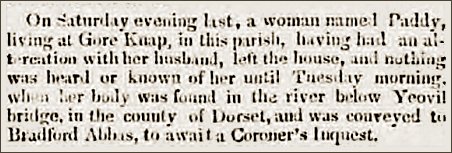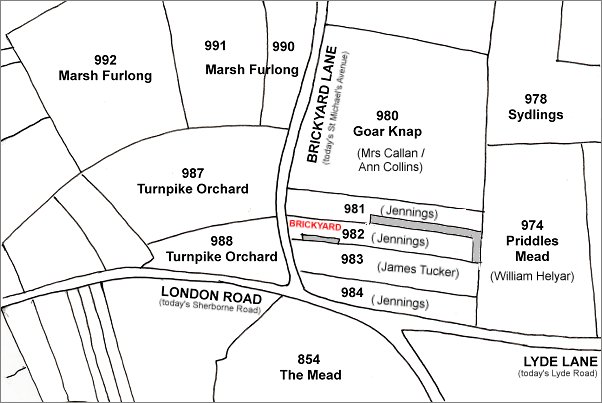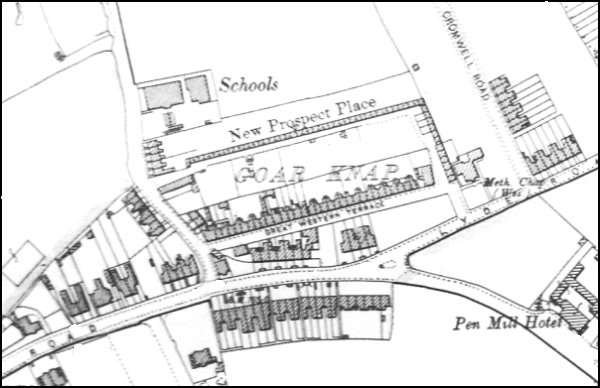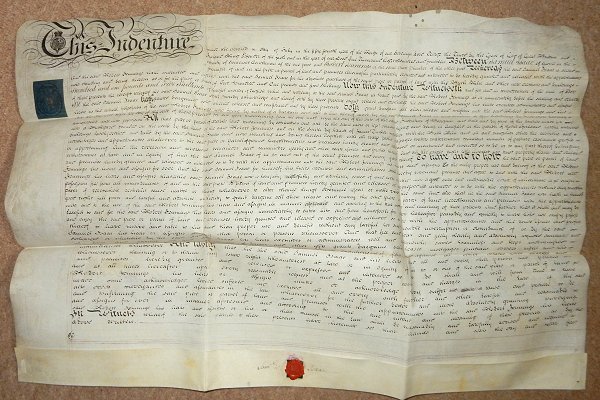new prospect place
new prospect place
Slum housing at Goar Knap
Goar Knap is that area of high ground containing Great Western Terrace and New Prospect Place. The name comes from the Anglo-Saxon gara, a gore, or triangular-shaped piece of land, and hnaep, for rising ground or the crest of a hill.
New Prospect Place was built between 1814 and 1829 on two thin strips of field - Nursery (Parcel 981) and the eastern end of Parcel 982 (the western end of 982 had been turned into a brickyard and would later be the site of the White Horse pub). It was also known as 'The Colony' and in the 1841 census as Jenning’s Buildings - named for the person who built them, Robert Jennings and his son William Jennings who owned them after the death of his father in 1848.
An indenture in my collection dated 2 July 1814 shows Robert Jennings to have purchased from Yeoman farmer Samuel Isaac, a brickyard for the sum of £201 5s (around £150,000 at today's value) on land to the south of land he already owned for the "absolute purchase of the same piece or parcel of land with the Brick Kiln and other new erections and buildings now standing and being thereon". The land was described as "All that piece or parcel of arable land containing by estimation one acre.... situate lying and being in Gorefield (Goar Knap) in the parish of Yeovil aforesaid lately converted into a Brickyard bounded on the north by the land of the said Robert Jennings and on the South by lands of James Tucker together with the Brick Kiln and all and singular other outhouse and buildings lately erected and built by the said Samuel Isaac and now standing and being thereon....".
An indenture dated 3 August 1829 in my collection is interesting as it refers to the lease of properties leased for one year by Robert Jennings 'Plumber & Glazier' to Glove Manufacturer William Snook. It also shows that Jennings built several houses on the site (New Prospect Place). The indenture refers to "All that Piece or Parcel of Arable Land containing one acre (more or less) lying in a certain Common Field called Gore Field [Goar Knap] in Yeovil aforesaid bounded on the east by Lands belonging to William Helyar Esquire on the west by Brickyard Lane (today's St Michael's Avenue) on the North by Lands belonging to Mrs Callan and on the South by the piece or parcel of Land hereinafter described And also all those several Messuages Dwellinghouses or Tenements and Premises which have been erected thereon by the said Robert Jennings And also All that piece or parcel of Arable Land containing by estimation one Acre (be the same more or less) situate lying and being in Gore Field aforesaid sometime since converted into a Brick Yard bounded on the north by the said piece or parcel of Land Hereinbefore mentioned and described on the South by Lands of James Tucker on the east by the said Lands of the said William Helyar Esquire and on the west by Brickyard Lane aforesaid with the Brick Kiln and all and singular other the erections and buildings now standing or being thereon All which said premises are now in the possession or occupation of the said Robert Jennings or his undertenants....".
New Prospect Place was a long terrace of small cottages, little better than slums and occupied by the very poorest families. The 1841 census lists a total of 143 people but, being farther from the centre of the town with its gloving factories, most of the men were labourers or agricultural labourers and it was the women who were gloving outworkers. Several people were described as paupers.
By the time of the 1846 Tithe Apportionment it appears that all of Robert Jennings land holdings had been sold although some, such as New Prospect Place, was leased by his son William from its new owner John Glyde.

Somerset County
Gazette, 16
November 1839
At the last count, in the 1901 census, there were still 137 people living in New Prospect Place.
The buildings were very tiny as may be seen by looking at the map below and comparing the size of the dwellings with, for instance, those in adjacent Great Western Terrace which themselves were only Victorian "two up, two down" houses. Indeed the dwellings in New Prospect Place were described as "simply huts with no foundations and originally having earth floors".
The following is
from an old
newspaper
cutting -
|
"Mary Jane King was eight years old when she died of fever at her home in Goar Knap, which in 1872 was one of the poorest parts of Yeovil. Her father John was a farm labourer with very little material wealth and no savings to pay for her funeral. Determined to take his daughter to the cemetery, he borrowed a handcart and placed the small coffin on it. He then set off along the muddy road through the nearby brickyard on his way to Preston Road. When some of the mothers living in Goar Knap (or, as it was described in the report, 'the Colony') heard of John King's mission, they set off after him determined to prevent the child being taken to the grave 'in such an indecent manner'. He had not gone far before the women caught up with him and forced him to return home. They took the coffin off the hand cart and clubbed together with their neighbours to pay for Mary Jane King to have a 'proper' funeral. Goar Knap was an area of poverty, and the living conditions were finally cleared when the old Yeovil Borough Council purchased the houses early in this century. The site, off St Michaels Avenue, was never redeveloped but turned into public allotments." |
In 1906 the medical officer of health reported to the town council that it comprised 52 houses in "wretched repair", some of them "in very dilapidated condition". The 200 inhabitants of these houses shared just 12 toilets or 'closets', and these were so built that anyone using them with the door ajar could be seen by people passing up or down the street.
Only 16 of the houses were provided with rainwater shootings, which fed into five downpipes. These discharged into small defective gullies and in hot weather the water was liable to evaporate and allow sewer gas to escape. The remaining houses were without any form of guttering at all and rainwater was allowed to drip directly from the eaves onto the roadway.
Laundry had to be done outdoors, under one of the six water taps which served the 52 houses. There was nowhere to deposit ashes from the fires that heated the houses, and although domestic rubbish was removed periodically by the council's scavenging team, there were no proper dustbins or receptacles.
Most of the houses had dirt floors which were often flooded because of the roadway in front of the houses had inadequate drainage. The road had no proper surface and was riddled with potholes in which rainwater and dirty water from the gullies beneath the six communal taps quickly accumulated.
Conditions were appalling, and as a result of the report the town council decided to have the houses cleared away. Even so they were not demolished until after 1911 and the land used as allotments, as it is to this day.
MAPs

This map,
based on the
1842 Tithe Map,
shows the
parcels of land
referred to in
the indentures
of 1814 and 1829
above. Parcel
982 was that
parcel "lately
converted into a
Brickyard",
Nursery (Parcel 981)
contained New
Prospect Place
built and owned
by Robert
Jennings (his
son William had
inherited the
lands by 1846) -
"bounded on the
north by the
land of the said
Robert
Jennings". Goar
Knap Field (Parcel 983)
was "on the
South by lands
of James Tucker"
- this is now
the site of
Great Western
Terrace and Goar
Knap Field
(Parcel 984) is
now occupied by
houses and
gardens on the
north side of
Sherborne Road
between St
Michael's Avenue
and Lyde Road.

The 1901 Ordnance Survey showing Goar Knap and New Prospect Place. The map shows that New Prospect Place comprised sixty separate dwellings.
GALLERY

From my
collection
The indenture dated 2 July 1814 in which Robert Jennings bought the brickworks from Samuel Isaac for £201 5s.

From my
collection
The indenture dated 3 August 1829 referred to above in which he leased out the brickyard as well as several houses of New Prospect Place he had built on the site.